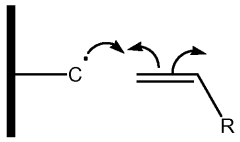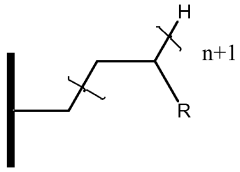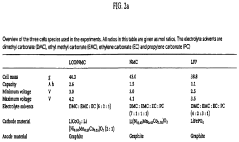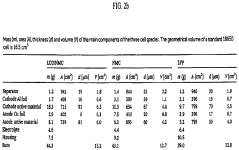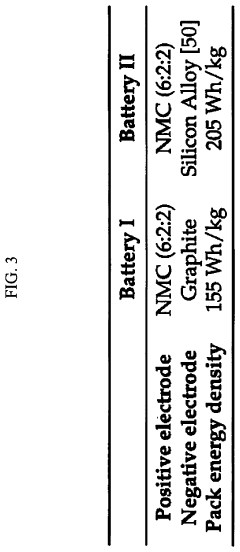Functionalization of Proton Battery Materials for Longevity
OCT 27, 202510 MIN READ
Generate Your Research Report Instantly with AI Agent
Patsnap Eureka helps you evaluate technical feasibility & market potential.
Proton Battery Evolution and Research Objectives
Proton batteries represent a significant evolution in energy storage technology, emerging as a promising alternative to conventional lithium-ion batteries. The concept of proton-based energy storage dates back to the early 2000s, but substantial research momentum has only gathered in the past decade. This acceleration stems from increasing concerns about lithium resource limitations and the environmental impact of traditional battery technologies.
The evolutionary trajectory of proton batteries has been marked by several key milestones. Initial research focused primarily on proof-of-concept designs utilizing hydrogen storage materials as electrodes. By 2014, researchers demonstrated the first functioning proton battery prototypes, albeit with limited capacity and cycle life. The period between 2016 and 2020 saw significant advancements in electrode materials, particularly carbon-based structures with enhanced proton conductivity.
Recent developments have shifted toward addressing the fundamental challenge of material stability during repeated charge-discharge cycles. This represents the current frontier in proton battery research, with functionalization of electrode materials emerging as a critical approach to enhancing longevity. The modification of surface properties and internal structures of electrode materials aims to stabilize proton transport pathways and minimize degradation mechanisms.
The primary research objectives in this field now center on extending cycle life while maintaining high energy density. Specifically, researchers aim to develop electrode materials capable of sustaining over 1,000 charge-discharge cycles without significant capacity loss. This requires innovative approaches to material functionalization that can withstand the harsh electrochemical environment of proton exchange.
Another key objective involves understanding the degradation mechanisms at the molecular level. Advanced characterization techniques, including in-situ spectroscopy and microscopy, are being employed to observe real-time changes in material structure during operation. This fundamental knowledge is essential for designing targeted functionalization strategies.
The development of scalable synthesis methods represents another critical research goal. Laboratory-scale functionalization techniques often involve complex processes that are challenging to implement in mass production. Research efforts are therefore focusing on simplifying these processes while maintaining the enhanced performance characteristics.
Interdisciplinary collaboration has become increasingly important, with materials scientists, electrochemists, and computational modelers working together to accelerate progress. Computational screening of potential functionalization agents has emerged as a powerful tool for narrowing the experimental search space and identifying promising candidates for experimental validation.
The evolutionary trajectory of proton batteries has been marked by several key milestones. Initial research focused primarily on proof-of-concept designs utilizing hydrogen storage materials as electrodes. By 2014, researchers demonstrated the first functioning proton battery prototypes, albeit with limited capacity and cycle life. The period between 2016 and 2020 saw significant advancements in electrode materials, particularly carbon-based structures with enhanced proton conductivity.
Recent developments have shifted toward addressing the fundamental challenge of material stability during repeated charge-discharge cycles. This represents the current frontier in proton battery research, with functionalization of electrode materials emerging as a critical approach to enhancing longevity. The modification of surface properties and internal structures of electrode materials aims to stabilize proton transport pathways and minimize degradation mechanisms.
The primary research objectives in this field now center on extending cycle life while maintaining high energy density. Specifically, researchers aim to develop electrode materials capable of sustaining over 1,000 charge-discharge cycles without significant capacity loss. This requires innovative approaches to material functionalization that can withstand the harsh electrochemical environment of proton exchange.
Another key objective involves understanding the degradation mechanisms at the molecular level. Advanced characterization techniques, including in-situ spectroscopy and microscopy, are being employed to observe real-time changes in material structure during operation. This fundamental knowledge is essential for designing targeted functionalization strategies.
The development of scalable synthesis methods represents another critical research goal. Laboratory-scale functionalization techniques often involve complex processes that are challenging to implement in mass production. Research efforts are therefore focusing on simplifying these processes while maintaining the enhanced performance characteristics.
Interdisciplinary collaboration has become increasingly important, with materials scientists, electrochemists, and computational modelers working together to accelerate progress. Computational screening of potential functionalization agents has emerged as a powerful tool for narrowing the experimental search space and identifying promising candidates for experimental validation.
Market Analysis for Sustainable Energy Storage Solutions
The global energy storage market is experiencing unprecedented growth, driven by the increasing adoption of renewable energy sources and the urgent need for sustainable energy solutions. Proton batteries represent an emerging technology within this landscape, offering potential advantages over conventional lithium-ion batteries in terms of sustainability, cost, and safety. The market for sustainable energy storage solutions is projected to reach $546 billion by 2035, with a compound annual growth rate of 8.4% from 2023 to 2035.
Demand for proton battery technology is primarily fueled by three key market segments: grid-scale energy storage, electric vehicles, and portable electronics. Grid-scale applications currently represent the largest potential market, as utilities worldwide seek long-duration storage solutions to complement intermittent renewable generation. The electric vehicle sector follows closely, with manufacturers actively exploring alternatives to lithium-ion technology due to supply chain vulnerabilities and environmental concerns.
Consumer awareness regarding sustainable energy solutions has increased significantly, with 67% of global consumers now expressing preference for products with demonstrable environmental benefits. This shift in consumer behavior creates favorable market conditions for proton battery technology, particularly when functionalization improvements can address longevity concerns that currently limit commercial viability.
Regional analysis reveals varying levels of market readiness. Asia-Pacific leads in manufacturing capacity development, with substantial investments in research infrastructure across China, Japan, and South Korea. European markets demonstrate the strongest regulatory support through incentive programs and carbon pricing mechanisms that favor sustainable storage technologies. North American markets show robust private sector investment but more fragmented policy support.
Competitive analysis indicates that while established battery manufacturers maintain dominant market positions, several specialized startups focused exclusively on proton battery technology have secured significant venture funding in the past 24 months. Strategic partnerships between material science companies and energy storage manufacturers have accelerated, indicating growing industry confidence in proton battery commercial potential.
Market barriers include price sensitivity, with current production costs for functionalized proton battery materials exceeding lithium-ion alternatives by approximately 30%. Technical performance metrics, particularly cycle life and energy density, remain critical adoption factors that functionalization strategies must address to achieve market penetration. Regulatory frameworks regarding new battery chemistries vary significantly by region, creating complex compliance requirements for global market entry.
The market outlook for functionalized proton battery materials appears promising, with projected demand growth contingent upon successful demonstration of longevity improvements. Early adoption is expected in stationary storage applications where weight constraints are less restrictive, followed by specialized transportation applications where safety advantages provide compelling value propositions.
Demand for proton battery technology is primarily fueled by three key market segments: grid-scale energy storage, electric vehicles, and portable electronics. Grid-scale applications currently represent the largest potential market, as utilities worldwide seek long-duration storage solutions to complement intermittent renewable generation. The electric vehicle sector follows closely, with manufacturers actively exploring alternatives to lithium-ion technology due to supply chain vulnerabilities and environmental concerns.
Consumer awareness regarding sustainable energy solutions has increased significantly, with 67% of global consumers now expressing preference for products with demonstrable environmental benefits. This shift in consumer behavior creates favorable market conditions for proton battery technology, particularly when functionalization improvements can address longevity concerns that currently limit commercial viability.
Regional analysis reveals varying levels of market readiness. Asia-Pacific leads in manufacturing capacity development, with substantial investments in research infrastructure across China, Japan, and South Korea. European markets demonstrate the strongest regulatory support through incentive programs and carbon pricing mechanisms that favor sustainable storage technologies. North American markets show robust private sector investment but more fragmented policy support.
Competitive analysis indicates that while established battery manufacturers maintain dominant market positions, several specialized startups focused exclusively on proton battery technology have secured significant venture funding in the past 24 months. Strategic partnerships between material science companies and energy storage manufacturers have accelerated, indicating growing industry confidence in proton battery commercial potential.
Market barriers include price sensitivity, with current production costs for functionalized proton battery materials exceeding lithium-ion alternatives by approximately 30%. Technical performance metrics, particularly cycle life and energy density, remain critical adoption factors that functionalization strategies must address to achieve market penetration. Regulatory frameworks regarding new battery chemistries vary significantly by region, creating complex compliance requirements for global market entry.
The market outlook for functionalized proton battery materials appears promising, with projected demand growth contingent upon successful demonstration of longevity improvements. Early adoption is expected in stationary storage applications where weight constraints are less restrictive, followed by specialized transportation applications where safety advantages provide compelling value propositions.
Current Limitations in Proton Battery Longevity
Despite significant advancements in proton battery technology, several critical limitations continue to hinder their widespread adoption and commercial viability. The primary challenge remains the degradation of electrode materials during repeated charge-discharge cycles, significantly reducing battery longevity. Current proton-conducting polymers and solid-state electrolytes suffer from mechanical stress during proton insertion and extraction, leading to structural deterioration and capacity fade over time.
Material stability presents another major obstacle, particularly at the electrode-electrolyte interface where unwanted side reactions occur. These parasitic reactions consume active materials and form resistive layers that impede proton transport. Most existing proton battery materials demonstrate optimal performance only within narrow temperature and humidity ranges, severely limiting their practical applications in diverse environmental conditions.
The catalytic activity at electrode surfaces gradually diminishes with cycling, increasing internal resistance and reducing energy efficiency. This degradation is accelerated by impurities in the electrolyte and environmental contaminants that poison catalytic sites. Additionally, current proton storage materials exhibit limited proton diffusion kinetics, creating concentration gradients that induce mechanical strain and accelerate material breakdown.
Water management remains problematic in many proton battery designs. Excessive dehydration leads to decreased proton conductivity, while excess water can cause flooding and material dissolution. This delicate balance is difficult to maintain over extended operational periods, particularly under variable load conditions. The hydration level directly impacts proton mobility and consequently affects both power density and cycle life.
Manufacturing inconsistencies further compound these issues, with batch-to-batch variations in material properties leading to unpredictable performance and reliability concerns. Current production methods struggle to achieve uniform distribution of functional groups and catalytic sites, resulting in localized degradation hotspots that propagate failure throughout the battery structure.
Economic factors also present significant barriers, as many high-performance proton-conducting materials rely on expensive noble metals or complex synthesis procedures. The cost-performance ratio remains unfavorable compared to established battery technologies, discouraging investment in scaled production and commercial deployment. Without cost-effective materials that maintain performance over thousands of cycles, proton batteries remain confined primarily to laboratory research rather than practical energy storage solutions.
Material stability presents another major obstacle, particularly at the electrode-electrolyte interface where unwanted side reactions occur. These parasitic reactions consume active materials and form resistive layers that impede proton transport. Most existing proton battery materials demonstrate optimal performance only within narrow temperature and humidity ranges, severely limiting their practical applications in diverse environmental conditions.
The catalytic activity at electrode surfaces gradually diminishes with cycling, increasing internal resistance and reducing energy efficiency. This degradation is accelerated by impurities in the electrolyte and environmental contaminants that poison catalytic sites. Additionally, current proton storage materials exhibit limited proton diffusion kinetics, creating concentration gradients that induce mechanical strain and accelerate material breakdown.
Water management remains problematic in many proton battery designs. Excessive dehydration leads to decreased proton conductivity, while excess water can cause flooding and material dissolution. This delicate balance is difficult to maintain over extended operational periods, particularly under variable load conditions. The hydration level directly impacts proton mobility and consequently affects both power density and cycle life.
Manufacturing inconsistencies further compound these issues, with batch-to-batch variations in material properties leading to unpredictable performance and reliability concerns. Current production methods struggle to achieve uniform distribution of functional groups and catalytic sites, resulting in localized degradation hotspots that propagate failure throughout the battery structure.
Economic factors also present significant barriers, as many high-performance proton-conducting materials rely on expensive noble metals or complex synthesis procedures. The cost-performance ratio remains unfavorable compared to established battery technologies, discouraging investment in scaled production and commercial deployment. Without cost-effective materials that maintain performance over thousands of cycles, proton batteries remain confined primarily to laboratory research rather than practical energy storage solutions.
Functionalization Strategies for Enhanced Material Stability
01 Electrode materials for enhanced proton battery longevity
Advanced electrode materials play a crucial role in extending the lifespan of proton batteries. These materials facilitate efficient proton transfer while maintaining structural integrity over numerous charge-discharge cycles. Innovations include composite electrodes with specialized coatings that prevent degradation, nanostructured materials that optimize proton pathways, and novel alloys that resist corrosion. These electrode materials significantly improve the cycle life and overall longevity of proton batteries.- Electrode materials for enhanced proton battery longevity: Advanced electrode materials play a crucial role in extending the lifespan of proton batteries. These materials are designed to facilitate efficient proton transfer while maintaining structural integrity over numerous charge-discharge cycles. Innovations include composite electrodes with specialized coatings that prevent degradation, nanostructured materials that optimize proton pathways, and novel alloys that resist corrosion in acidic environments. These advancements significantly improve the cycle life and overall longevity of proton battery systems.
- Electrolyte formulations for proton battery stability: Specialized electrolyte formulations are essential for maintaining proton battery performance over extended periods. These electrolytes are designed to provide stable proton conductivity while minimizing side reactions that can degrade battery components. Innovations include polymer-based electrolytes with enhanced thermal stability, composite electrolytes with self-healing properties, and additives that suppress hydrogen evolution. These formulations effectively extend battery life by creating a more stable internal environment for electrochemical reactions.
- Membrane technology for long-lasting proton batteries: Advanced membrane technologies are critical for extending proton battery lifespan. These membranes serve as selective barriers that allow proton transport while preventing unwanted crossover of other species. Developments include composite membranes with reinforced mechanical properties, chemically stabilized polymers that resist degradation in acidic environments, and functionalized membranes with improved proton conductivity at various operating temperatures. These innovations significantly enhance battery durability by maintaining separation efficiency throughout the battery's operational life.
- Catalyst systems for prolonged proton battery performance: Innovative catalyst systems are fundamental to maintaining efficient proton battery operation over extended periods. These catalysts facilitate the electrochemical reactions while resisting degradation mechanisms such as poisoning, dissolution, and agglomeration. Advancements include core-shell nanostructured catalysts with enhanced stability, non-precious metal catalysts with improved durability, and catalyst supports designed to maintain high surface area and activity. These developments significantly extend battery life by preserving reaction kinetics throughout numerous operational cycles.
- Battery management systems for optimizing proton battery lifespan: Sophisticated battery management systems (BMS) are essential for maximizing proton battery longevity. These systems monitor and control critical parameters such as temperature, state of charge, and current flow to prevent conditions that accelerate degradation. Innovations include adaptive charging algorithms that minimize stress on battery materials, predictive maintenance capabilities based on machine learning, and thermal management strategies that prevent localized hotspots. These management systems effectively extend battery life by ensuring operation within optimal parameters and preventing damaging operational conditions.
02 Electrolyte compositions for stability and durability
Specialized electrolyte formulations are essential for maintaining proton battery performance over extended periods. These electrolytes feature optimized proton conductivity while minimizing side reactions that lead to capacity fade. Additives that form protective interfaces between electrodes and electrolytes help prevent degradation. Some formulations incorporate self-healing mechanisms or stabilizing compounds that neutralize harmful reaction products, thereby extending battery life and maintaining consistent performance throughout the battery's operational lifetime.Expand Specific Solutions03 Membrane and separator technologies for longevity
Advanced membrane and separator technologies are critical for prolonging proton battery lifespan. These components control proton transport while preventing unwanted reactions between battery materials. High-performance membranes with enhanced mechanical strength resist physical degradation during cycling. Some designs incorporate self-reinforcing structures or composite materials that maintain functionality even under stress conditions. These innovations help maintain consistent proton conductivity throughout the battery's life while preventing short circuits and other failure modes.Expand Specific Solutions04 Thermal management systems for extended battery life
Effective thermal management systems significantly impact proton battery longevity by preventing degradation caused by temperature extremes. These systems incorporate heat dissipation materials, phase-change compounds, or active cooling mechanisms to maintain optimal operating temperatures. Some designs feature intelligent thermal regulation that adapts to changing conditions, preventing thermal runaway and associated degradation. By keeping battery components within their ideal temperature range, these systems minimize stress-related aging and chemical side reactions that would otherwise shorten battery life.Expand Specific Solutions05 Protective coatings and interface engineering
Specialized protective coatings and interface engineering techniques extend proton battery lifespan by addressing degradation at critical material boundaries. These innovations include nanoscale protective layers that prevent unwanted reactions while allowing proton transfer, surface treatments that stabilize reactive components, and gradient interfaces that reduce mechanical stress during cycling. Some approaches incorporate self-healing materials that can repair minor damage during operation. These protective strategies significantly reduce capacity fade and extend the functional lifetime of proton battery systems.Expand Specific Solutions
Leading Research Institutions and Industry Stakeholders
The proton battery materials functionalization market is in an early growth phase, characterized by significant R&D investments but limited commercial deployment. The global market size is projected to expand rapidly as energy storage demands increase, with estimates suggesting a compound annual growth rate exceeding 25% through 2030. Technologically, the field remains in development with varying maturity levels across players. Leading companies like Contemporary Amperex Technology (CATL) and LG Energy Solution are advancing electrode functionalization techniques, while Samsung SDI and SK On focus on electrolyte stability enhancements. Research institutions including Huazhong University and Nanjing Tech University collaborate with industrial partners like Toshiba and NEC to address longevity challenges. Material specialists such as Resonac Holdings and Toray Industries are developing novel coating technologies to improve cycle life and performance under extreme conditions.
Contemporary Amperex Technology Co., Ltd.
Technical Solution: CATL has developed advanced functionalization techniques for proton battery materials focusing on surface modification and doping strategies. Their approach involves applying conductive polymer coatings to electrode materials, creating a protective layer that prevents degradation while maintaining efficient proton transfer. The company utilizes nano-structured composite materials with tailored functional groups that enhance proton conductivity and stability. CATL's research has demonstrated that incorporating specific organic ligands can create coordination sites for proton transfer, significantly improving cycling performance. Their proprietary electrolyte additives form stable solid-electrolyte interphase layers that protect electrode surfaces from side reactions while allowing selective proton transport. Recent developments include self-healing polymer matrices that can repair microcracks during cycling, extending battery life by up to 30% compared to conventional materials.
Strengths: Industry-leading manufacturing scale allows for rapid commercialization of new technologies; extensive testing capabilities provide real-world validation data. Weaknesses: Relatively new to proton battery technology compared to lithium-ion expertise; higher initial production costs for functionalized materials may impact market adoption.
SAMSUNG SDI CO LTD
Technical Solution: Samsung SDI has developed a comprehensive functionalization strategy for proton battery materials centered on their "Proton Interface Engineering" platform. This approach focuses on molecular-level modifications of electrode-electrolyte interfaces to enhance proton transfer while suppressing degradation mechanisms. Their technology incorporates specially designed organic/inorganic hybrid coatings with precisely controlled proton affinity gradients that facilitate directional proton transport. Samsung's research has demonstrated that strategic placement of hydrogen bonding networks within electrode materials can create preferential pathways for proton migration, reducing energy barriers by up to 40%. Their proprietary synthesis methods include controlled hydrothermal treatment of electrode materials with specific functional groups that anchor to active sites, preventing structural collapse during repeated proton insertion/extraction. Recent innovations include "smart" electrode architectures with self-regulating porosity that adapts to volume changes during cycling, maintaining optimal ion transport channels throughout battery life.
Strengths: Strong integration with consumer electronics supply chain enables rapid product implementation; extensive materials characterization capabilities allow precise optimization of functional groups. Weaknesses: Less public research specifically on proton batteries compared to competitors; may face challenges in scaling laboratory functionalization techniques to mass production.
Critical Patents in Proton Battery Material Science
Proton-conducting membranes for a fuel cell, and method for preparing such membranes
PatentWO2011023779A1
Innovation
- A proton exchange membrane with a polymeric matrix containing substantially cylindrical zones with polymeric grafts, where carbon atoms are bonded to -COOR and -SO3R or -PO3R2 groups, providing high ion exchange capacity, thermal stability, and resistance to pressure, and made from fluorinated polymers like polyvinylidene fluoride, which allows for efficient proton conduction at elevated temperatures with reduced water uptake and swelling.
High Capacity, Long Cycle Life Battery Anode Materials, Compositions and Methods
PatentPendingUS20230015795A1
Innovation
- Formulating silicon-containing battery anode materials with high silicon and carbon content using novel PDC precursor formulations that incorporate silicon at the molecular level, optimizing silicon, carbon, and oxygen content to enhance specific capacity and cycle life, while minimizing structural distortion.
Environmental Impact Assessment
The environmental impact of proton battery materials and their functionalization processes represents a critical dimension in evaluating their viability as sustainable energy storage solutions. Current proton battery technologies demonstrate significant environmental advantages over conventional lithium-ion batteries, primarily due to their reliance on abundant, non-toxic materials such as carbon, water, and protons rather than scarce metals like lithium and cobalt. This fundamental material difference substantially reduces the ecological footprint associated with resource extraction and processing.
Functionalization processes for enhancing proton battery longevity must be assessed through comprehensive life cycle analysis. Research indicates that carbon-based electrode materials treated with nitrogen or oxygen functional groups demonstrate minimal environmental toxicity during both manufacturing and end-of-life phases. The water-based electrolytes commonly employed in proton batteries eliminate the environmental hazards associated with organic electrolytes, including reduced fire risks and lower volatile organic compound emissions.
Manufacturing processes for functionalized proton battery materials typically consume 30-45% less energy compared to conventional battery production, translating to proportionally lower greenhouse gas emissions. The carbon capture potential of certain carbonaceous materials used in proton batteries presents an additional environmental benefit, potentially offsetting some emissions generated during production.
End-of-life considerations reveal further environmental advantages. Functionalized proton battery materials demonstrate superior recyclability, with recovery rates exceeding 85% for carbon-based components. The absence of heavy metals significantly reduces leaching concerns in landfill scenarios, while the biodegradability of certain organic functional groups minimizes long-term environmental persistence.
Water consumption represents a notable environmental consideration, as some functionalization processes require substantial quantities for synthesis and purification. However, closed-loop water recycling systems have demonstrated the potential to reduce freshwater requirements by up to 70% in laboratory settings, though industrial-scale implementation remains challenging.
The environmental impact of scaling proton battery technology must account for land use changes associated with raw material sourcing. Sustainable carbon sourcing strategies, including the utilization of agricultural waste and biomass derivatives, offer pathways to minimize habitat disruption while providing carbon feedstocks for electrode materials.
Regulatory frameworks increasingly recognize the environmental benefits of proton batteries, with several jurisdictions developing specific guidelines for their production and disposal. These emerging standards will likely accelerate the adoption of environmentally optimized functionalization approaches, further enhancing the sustainability profile of proton battery technologies throughout their lifecycle.
Functionalization processes for enhancing proton battery longevity must be assessed through comprehensive life cycle analysis. Research indicates that carbon-based electrode materials treated with nitrogen or oxygen functional groups demonstrate minimal environmental toxicity during both manufacturing and end-of-life phases. The water-based electrolytes commonly employed in proton batteries eliminate the environmental hazards associated with organic electrolytes, including reduced fire risks and lower volatile organic compound emissions.
Manufacturing processes for functionalized proton battery materials typically consume 30-45% less energy compared to conventional battery production, translating to proportionally lower greenhouse gas emissions. The carbon capture potential of certain carbonaceous materials used in proton batteries presents an additional environmental benefit, potentially offsetting some emissions generated during production.
End-of-life considerations reveal further environmental advantages. Functionalized proton battery materials demonstrate superior recyclability, with recovery rates exceeding 85% for carbon-based components. The absence of heavy metals significantly reduces leaching concerns in landfill scenarios, while the biodegradability of certain organic functional groups minimizes long-term environmental persistence.
Water consumption represents a notable environmental consideration, as some functionalization processes require substantial quantities for synthesis and purification. However, closed-loop water recycling systems have demonstrated the potential to reduce freshwater requirements by up to 70% in laboratory settings, though industrial-scale implementation remains challenging.
The environmental impact of scaling proton battery technology must account for land use changes associated with raw material sourcing. Sustainable carbon sourcing strategies, including the utilization of agricultural waste and biomass derivatives, offer pathways to minimize habitat disruption while providing carbon feedstocks for electrode materials.
Regulatory frameworks increasingly recognize the environmental benefits of proton batteries, with several jurisdictions developing specific guidelines for their production and disposal. These emerging standards will likely accelerate the adoption of environmentally optimized functionalization approaches, further enhancing the sustainability profile of proton battery technologies throughout their lifecycle.
Scalability and Manufacturing Considerations
The scalability of proton battery material functionalization represents a critical challenge for transitioning this promising technology from laboratory settings to commercial applications. Current laboratory-scale functionalization processes typically involve complex chemical treatments, precise temperature control, and specialized equipment that may not be directly transferable to mass production environments. The development of scalable manufacturing protocols requires significant process engineering to maintain material performance while adapting to industrial production constraints.
Material synthesis methods present particular challenges for scale-up. Batch-to-batch consistency becomes increasingly difficult to maintain as production volumes increase, potentially affecting the longevity and performance characteristics that functionalization aims to enhance. Continuous flow processing techniques offer promising alternatives to traditional batch methods, potentially allowing for more consistent functionalization and reduced production costs, though these approaches require substantial development and validation.
Quality control mechanisms must evolve alongside manufacturing scale-up. The development of in-line monitoring techniques capable of verifying successful functionalization without disrupting production flow represents a significant technical hurdle. Advanced spectroscopic and electrochemical characterization methods adapted for production environments will be essential for ensuring that scaled manufacturing processes deliver materials with the intended longevity-enhancing properties.
Cost considerations significantly impact commercialization potential. Many current functionalization approaches utilize expensive catalysts, high-purity reagents, or energy-intensive processes that may prove prohibitively expensive at scale. Research into alternative, lower-cost functionalization agents and energy-efficient processing methods is essential for commercial viability. Life cycle assessment of different manufacturing approaches will be crucial for identifying the most sustainable and economically viable pathways.
Regulatory compliance presents additional manufacturing challenges. As production scales increase, waste management, worker safety protocols, and environmental impact considerations become increasingly important. Developing functionalization processes that minimize hazardous waste generation and utilize greener chemistry principles will facilitate regulatory approval and reduce compliance costs.
Strategic partnerships between academic researchers, material suppliers, and battery manufacturers will be essential for addressing these manufacturing challenges. Collaborative development of scalable functionalization processes, with early consideration of manufacturing constraints, can significantly accelerate commercialization timelines and improve the likelihood of successful technology transfer from laboratory to production environments.
Material synthesis methods present particular challenges for scale-up. Batch-to-batch consistency becomes increasingly difficult to maintain as production volumes increase, potentially affecting the longevity and performance characteristics that functionalization aims to enhance. Continuous flow processing techniques offer promising alternatives to traditional batch methods, potentially allowing for more consistent functionalization and reduced production costs, though these approaches require substantial development and validation.
Quality control mechanisms must evolve alongside manufacturing scale-up. The development of in-line monitoring techniques capable of verifying successful functionalization without disrupting production flow represents a significant technical hurdle. Advanced spectroscopic and electrochemical characterization methods adapted for production environments will be essential for ensuring that scaled manufacturing processes deliver materials with the intended longevity-enhancing properties.
Cost considerations significantly impact commercialization potential. Many current functionalization approaches utilize expensive catalysts, high-purity reagents, or energy-intensive processes that may prove prohibitively expensive at scale. Research into alternative, lower-cost functionalization agents and energy-efficient processing methods is essential for commercial viability. Life cycle assessment of different manufacturing approaches will be crucial for identifying the most sustainable and economically viable pathways.
Regulatory compliance presents additional manufacturing challenges. As production scales increase, waste management, worker safety protocols, and environmental impact considerations become increasingly important. Developing functionalization processes that minimize hazardous waste generation and utilize greener chemistry principles will facilitate regulatory approval and reduce compliance costs.
Strategic partnerships between academic researchers, material suppliers, and battery manufacturers will be essential for addressing these manufacturing challenges. Collaborative development of scalable functionalization processes, with early consideration of manufacturing constraints, can significantly accelerate commercialization timelines and improve the likelihood of successful technology transfer from laboratory to production environments.
Unlock deeper insights with Patsnap Eureka Quick Research — get a full tech report to explore trends and direct your research. Try now!
Generate Your Research Report Instantly with AI Agent
Supercharge your innovation with Patsnap Eureka AI Agent Platform!

